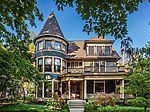Exodus Refugee Immigration
Exodus Refugee Immigration is a refugee resettlement agency located in Indianapolis, Indiana. Exodus programs focus on receiving refugees as they arrive in the United States, helping them find apartments and jobs, learning English, and becoming financially self-sufficient. It has resettled refugees from Burma, Democratic Republic of Congo, Syria, Central African Republic, Afghanistan, Central African Republic, Eritrea, Iraq, Somalia, and El Salvador, among other countries, and assists people of from many countries, cultures, languages, faiths, and political opinions.Exodus Refugee Immigration only resettles people who have been granted refugee status by the United Nations and who have been vetted and pre-approved by the United States Government, which issues them valid refugee visas. It is affiliated with a national VOLAGs, Church World Service (CWS), which is assigned by the US Government's Office of Refugee Resettlement, which also provides funds for initial resettlement. These funds are channeled through the VOLAGs into local resettlement agencies such as Exodus, who provide short-term assistance with housing, employment services, ESL and financial services to the incoming refugees. Refugees resettled by Exodus are assisted by local welcome teams, made up of volunteers from religious organizations and other community groups. These welcome teams help refugees complete required medical exams, enroll their children in schools, and learn English.
Excerpt from the Wikipedia article Exodus Refugee Immigration (License: CC BY-SA 3.0, Authors).Exodus Refugee Immigration
South Tacoma Avenue, Indianapolis Westminster/St. Philip Neri (Near Eastside)
Geographical coordinates (GPS) Address Nearby Places Show on map
Geographical coordinates (GPS)
| Latitude | Longitude |
|---|---|
| N 39.767375 ° | E -86.119986 ° |
Address
South Tacoma Avenue
46201 Indianapolis, Westminster/St. Philip Neri (Near Eastside)
Indiana, United States
Open on Google Maps









